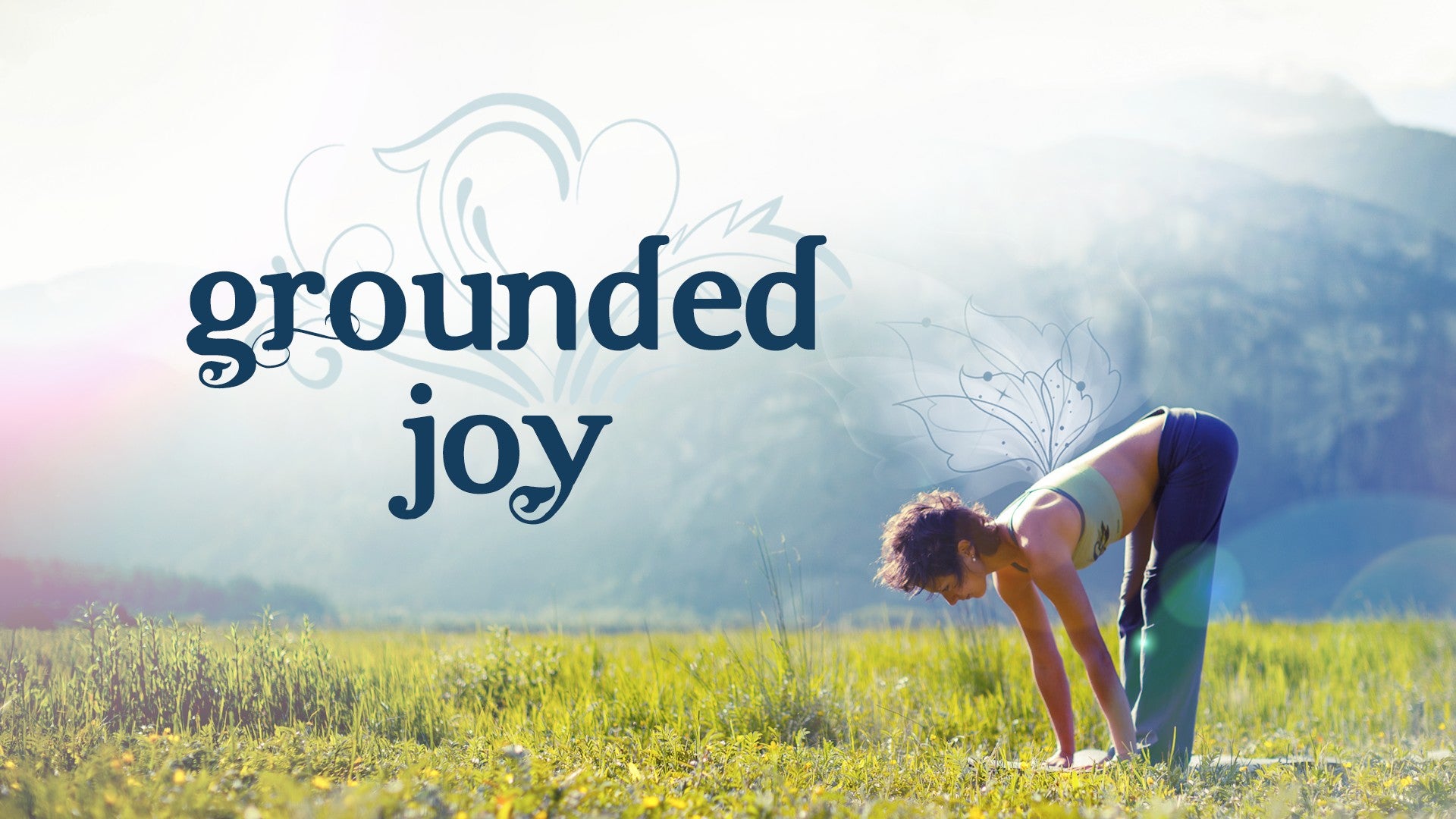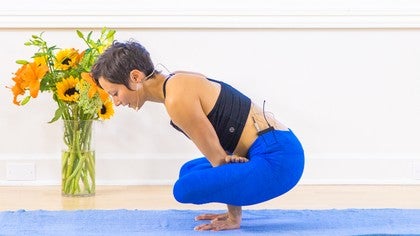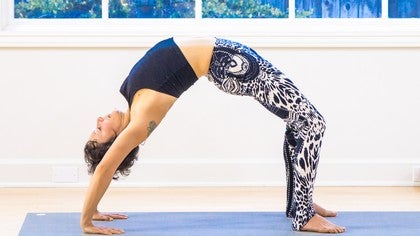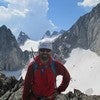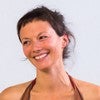Description
About This Video
Transcript
Read Full Transcript
(waves crashing) Welcome. This is a short tutorial on a few things that might make the lotus pose padmasana a little bit more manageable, or move you towards it or even half lotus, half padmasana. Or, I mean eventually it's to lead you towards, maybe being able to sit in padmasana for a seated meditation. So I'll go through a few things. I think it's commonly known that external hip rotation helps with the lotus pose quite a bit.
But there are a few other factors. In fact, the whole cylinder of the thigh, the opening of the fascia, I mean not so much in the hamstring because the leg is bent. But in the inner thigh, so if the knee is floating up often there's a tightness in the inner thigh and that allows the knee to come a little bit closer to the floor. Also, the quadricep, because the front line of the leg is getting bent like this. So the quadricep pulling might pull on the kneecap.
And of course the external hip rotation. So I wanted to show a few things that might help open this up. But I do have to say that, in my experience the way to open your hips, is to sort of stop sitting in chairs as much. Or if you sit in chairs, is it possible to sit in kind of a crossed leg position? When you're at home can you sit on the floor?
And then of course a seated meditation or promena practice. If you can relax deeply into a seated meditation, there is something that happens in the body that relaxes in the hips. And if you're doing an hour of sitting practice, most likely that is where your hips are gonna open, instead of doing a few hip openers. But I wanted to show you this stuff anyways. So what's useful for this practice, is a yoga strap if you have one.
You may not have one of these kicking around, but theraband, and I think in one of my videos I called it a teraband, but I stand corrected. It is a theraband, t-h-e-r-a. And in most physio clinics, you can get one of these. They have a stretch to them. And the reason I like using them, is because they're a lot more like the body.
They have this dynamic stretch and widening quality to them. So if you're strapping yourself up, like the first step might be to use a strap because it would really hold you there. And then to come away from the crutch of the strap you can use the theraband, which has a little bit more of a play to it, so it would move you towards supporting yourself in that way a little bit more on your own. So that. And a bolster.
So we're gonna start with the bolster. So bolster, in front, cross-legged position and letting one leg come up onto the bolster, the shin on a diagonal. And you might want this to be a little bit higher. And you just want to watch that your shin bone doesn't externally rotate too much more than your knee is. So if you can kind of keep the center of the knee aligned over the second toe.
I mean, it's okay if a little bit of that happens but, I think generally that's called torque in the knee joint. And we're gonna work with that in a little bit. So, higher yourself up so that you can have that sort of support. You can use a blanket as well on top of the bolster, like that. And then we're gonna fold forward.
So I'll walk my hips back a bit and already I can feel a little bit more opening in my outer hip just by walking back like that. I'm gonna flex my heel a little bit. It's a feeling of like beaming your heel away from your achilles tendon. Just like that a little bit. I mean, not to harden the front of your foot, but just to get a sense of lengthening and then, a sense of kind working all the smaller muscle chains all the way up through the knee joint, instead of having a totally lax lower leg.
Which, kind of the force of the posture could end up there. So I'm kind of bringing it all the way into my foot. And then we're gonna fold forwards. And there always, every truth seems to be a paradox. So if there's a little bit of engagement, pour a little of softness into it.
If there's too much engagement of course there's gonna be an overlay of stiffness. If there's too much laxicity, then there's a little bit more of a danger of overstretching the ligaments. I find this one really useful. So as you come forwards you can start to feel this lateral line of the leg opening. Most of you know pigeon pose, that's another one, or box pose, double pigeon.
And in sort of a yin style hold, with maybe a tiny bit of engagement, is useful to get into that external rotation. I find this one really useful, and if you're ever working with, a safe leg behind the head, this is also a really nice way to prepare the hips for that opening. One more thing. In this position, you could curl your spine. And for me it takes it a little bit out of the hip, but if you relax your lower belly, just above your pubic bone, you press your pubic bone down and you lengthen your spine.
I'm feeling that a lot more in the hip and the outer hip. And even in the inner line of the leg and the inner groin. So let's try the other side. So make sure that you can see that there's not too much torque happening in the knee. There's a little bit of a beaming of the heel away.
I'm gonna walk my sit bones back and just like when walking my sit bones, I'm walking on my sit bones. One moves back, the other moves back. And then fold forwards any amount. And I can feel it a lot, sitting up like this. But as I come down I'm gonna just progressively feel it a little bit more.
I'm also making a little bit of an effort in my leg to drop the outer knee down towards the floor because as the outer knee drops down towards the floor, that's how I'm gonna get my leg into the lotus pose. So same thing on the other side. It's this movement to start and I kind of want this, outer knee to come down. So that I can sort of keep the torque out of the knee. There will be a tiny bit happening when I take the foot on top of the thigh.
And I'm right of my right sit bone like that. So this is the beginning of that movement. So again if you're in this position and you feel, there's like, your lower belly's an accordion and it's contracting like that, it's shortening, can you lengthen from the pubic bone to the belly button? Without like hardening your back, but just lengthening. And then come forwards.
Generally if you don't breathe in the postures they're not as effective. Cuz it's like I was talking about in meditations. If you can go into a deep state of relaxation in meditation, your tissues relaxed. Your whole body as one muscle responds to the relaxation and maybe the unconscious tension that is potentially held in your body. You might not even know about it.
Like checking in with your eyes and your jaw. And since you're all connected through this intricate fascial network, if you relax your jaw you could be simultaneously relaxing your hip. Or if you even relax that thought, that maybe you're not good enough, you could be relaxing your hip. Okay let's come up. Quadriceps stretch.
Our front line of the leg. So, we have this tendency to break up our body into these, boxes of muscle. But really the front line leg of fascia, that holds all these muscle bundles and goes all the way down the front of the leg. So it's continuous chain. Thomas Myers talks a lot about this in his anatomy trains-work.
And I'm pretty sure Arturo Peal does a really neat little nugget about fascia and muscles on this site. So lets turn around. And first of all come down onto a bolster or a block or a blanket. You might be able to come all the way down, but I just want to show you something in the feet that my teacher Joy Irwin showed me that helps to bring it a little bit more into the front line of the leg. One little subtle detail, if you hold onto your kneecap and lift it up, and kind of pull the skin that's being tugged downwards on your knee up.
I mean I can feel that already a relief in my knee joint, especially if you're wearing tight pants. That, there's compression happening in the pant. It's they're really tight pants, are actually telling the first layer of your fascia to tighten. So make sure you have a good amount of space sometimes. I get that sometimes you want more support.
So another thing that you can do that's subtle in virasana is come forwards, take your thumb into the back of the center of the calf, and slide it out to the side. And same thing on the other side. So, not too much, cuz you don't want to create a twisting in your skin, or your fascia. But maybe just a little bit. And then, coming down.
Those two little things, I just feel a little more spacious in the knees. With enough height, I can get the feeling here of dragging my toe nails towards the knee and sucking the heel back and then sucking the ankle in. I feel this a lot more in the front of the thighs. It's sort of tugging the whole front line of fascia into more of a stretch. And that might not be possible when you're sitting right down on the floor.
Of course to get a little bit deeper into this area and then also into the groin, if you have some stickiness in the supta virasana. So it might be possible for you to come down. And depending on what's happening in your ankle joint, really rolling your foot in like that and having a rounding to the outer ankle joint is not as nice, I mean it doesn't box the joint in the center. So think about your joint in a little box. And it might hit the sides and then create a sort of grinding or just a congestion so there's not so much free movement.
So think about boxing the ankle joint, the knee joint as well so it doesn't rotate too much in, or too much out. And then you might come back. I like to come back here, sneak my tail bone under a little bit. And then lengthen, lengthen, lengthen. Of course you can do this right on the floor.
Feels nice to maybe take your arms over your head. So you can feel how that, opens up the front line. To come out, see if you can do it as symmetrical as possible on the two sides of the spine. And that posture is a deep compression of the knee joint so it feels good to move around like this and flesh the lower leg or come into downward facing dog and flesh the leg. Of course you can stay there for a much longer time, but just for this tutorial, the purpose of this tutorial, I'm gonna keep going.
Inner line of the leg. Konasana, yin style is a nice one to get in there. And you can use a bolster support. You can also lift your hips up so that you're getting into this inner line. You can also do this lying on your back for a five minute hold with your legs up the wall.
And it's nice to sort of support the outer line of the legs when you're up the wall. So your legs, the inner groin isn't just, kind of hanging, the weight of the legs isn't just, hanging on the ligaments. So either hands, or a couple of blocks or pillows underneath your outer hips, if you're doing it against the wall. Okay. The knee joint, in the external rotation.
This is where this stuff comes in handy. I learned this one from one of my teachers, named Mark Darby, who's a Canadian guy. Has a studio in Montreal. And at first I really didn't like this at all. Then after years and years of practice it started to really make sense to me.
But often I don't really like being strapped up in position so, I don't know if you feel the same way. But this is helpful. So I'm gonna take the strap and we'll start with the strap, and on the other side I'll show with the teraband. But I'm strapping the upper and the lower leg together. So what I'm doing is sealing the knee joint so there's a minimal amount of that torquing the two different spirals of direction at the knee joint.
So I'm gonna make this pretty snug so that I feel like, if I lean over to one side and I start to do rotations, this is even really nice because I'm feeling the rotation go directly into the hip joint. And I can actually feel, if I relax enough, if the femur bone is hitting a hard edge in the hip joint. And I once had a cranial sacral therapist just allow me to relax on the floor and manipulate my leg like this, sealing the knee joint. And I could feel when the knee joint was in, swimming in the synovial fluid. And I could feel when it was grinding against the bone or other thicker tissues.
So you want to be swimming in your hips. Okay. We're gonna take this leg like this in a seated position. You might need to come up a bit higher if you feel very constricted. And then we're gonna open the hip into external rotation and just see where it goes.
And there's not too much happening in my knee joint there. Then I'm gonna take my left, or my opposite leg, heel, towards the bum and see if I can bring this foot towards the upper groin like I would be going into half lotus. When I bring the foot up onto the thigh, that little movement is gonna create a little bit of that torquing. Like I can feel it on the strap, but I'm just trying to minimize that feeling. And that feels great.
So you can play around with that. You can also play around with this. And here, because I'm not moving the knee joint at all, what's happening is that I am cycling in the ankle a little bit. This kind of movement, the joint, what I was talking about is not so much boxed anymore. I mean it's okay to get a little bit of this movement.
But if you're there for a while and you start to feel like your foot is falling asleep or it turns purple or you know, there's a pain cuz you can feel there's an overstretch, just come out. And you can work with this, by leaning the inner heel a little bit away. So it's not so much the outer heel that's moving away all the time. It's a little bit of the inner heel. And when I do that, my knee is a little bit further off.
So I'm working with containing this. So I'm exaggerating it, but when you're, you know, when you're in it, you might relax it a little bit. Okay so let's look at the other side. When I did this with Mark Darby he got us to do marichyasana in this position. You know, all of the different, ashtanga primary series movements.
Strapped up like this, everyone got so frustrated. I'm going to, use the teraband. The things with terabands, I'm doubling it up. Depending on the thickness, I'm saying teraband, it's theraband. Depending on the thickness of it, you don't want it to rip right, so maybe doubling it up is a good idea if you're putting a lot of force into it.
So there's quite a bit more play with this. Then I'm just gonna work with hip rotations, which I have a little bit of play but there's a little bit of containment. And I think I said this, but as far down towards the hip joint as you can. And then I'm gonna, this movement that we often do to come into it, taking the hand underneat the shin bone, it does create torque. So I'm actually going to come around, hold the whole leg and place it up there.
Little bit of energy in the inner heel, maybe coming up on something. I learned this one from Eric Schiffman, who has a great padmasana video in his backyard yoga series. But this leg, once you get one leg into half lotus, if you lean over, lift your hip, it's okay if this is floating. But once this knee is on the ground, then sliding the ankle up the inner thigh and then coming back center. Little bit of energy in the inner heels and then just relax.
And just sit here for a few moments. Definitely don't have to be in padmasana pose to meditate or breathe or anything like that. There's so many other ways to, have a connection to the Earth. But I do find in this posture, the way the sitting bones are rolling underneath you, you don't have to do anything in the pelvic floor and it creates this mula bandha sensation that everybody talks about. This subtle, lifting of the pelvic floor without you doing anything.
And somehow that supports the spinal column so that you can almost move with the wave of your breath. There's a fluidity. There's an awareness of the fluid around the spine. And there's this ability to relax in this strong, connected base. Thanks for watching.
Namaste.
Grounded Joy
Comments
This is a great tutorial. I can't even sit cross legged comfortably without getting sore ankles and knees. I'm getting more and more drawn into yoga and finding I'm currently limited in so many ways from years of just not paying attention or not feeling any importance regarding those limitations.
I loved your happy and healthy hips class! Just did that recently! Love!
You need to be a subscriber to post a comment.
Please Log In or Create an Account to start your free trial.
